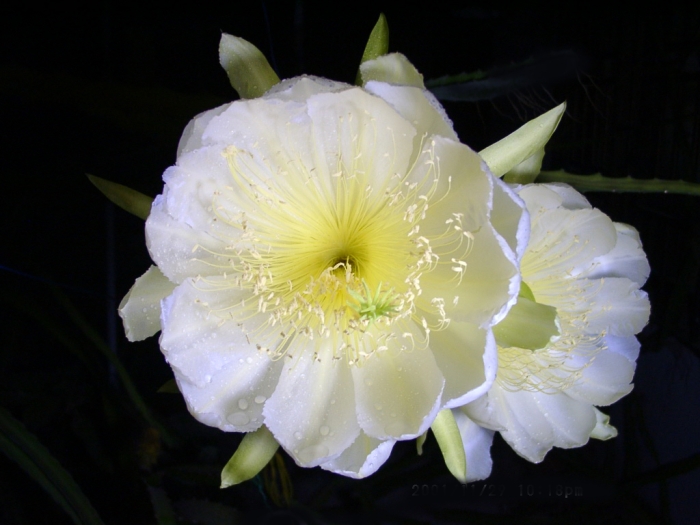Yellow Dragon Fruit
(Selenicereus megalanthus)
Yellow Dragon Fruit (Selenicereus megalanthus)
/
/

Edward
Copyrighted free use
Image By:
Edward
Recorded By:
Copyright:
Copyrighted free use
Copyright Notice:
Photo by: Edward | License Type: Copyrighted free use | License URL: Copyrighted free use | Uploader: Epibase | Publisher: Wikimedia Commons | Title: Hylocereus_megalanthus1EDWARD.jpg | Notes: User created page with UploadWizard |








Estimated Native Range
Summary
Selenicereus megalanthus, commonly known as Yellow Dragon Fruit, is an evergreen climbing cactus native to tropical forests in northern South America. It is renowned for its large, showy, nocturnal, and fragrant flowers, which are among the largest of all cactus species, and its sweet yellow fruit. The plant can reach substantial sizes, with stems that may lie along the ground (procumbent), climb (scandent), or hang (pendent). The flowers are white and funnel-shaped, blooming from June to October. The ovoid fruit is notable for its yellow skin and spiny exterior, with a pleasant, mildly sweet flavor. Yellow Dragon Fruit is self-fertile, making it a popular choice for commercial fruit production as well as ornamental use.
Yellow Dragon Fruit is valued for its ornamental appearance, particularly its impressive flowers and unique fruit. It is often grown on trellises or fences in tropical and subtropical gardens and can be cultivated indoors in cooler climates. The plant requires a compost rich in humus, consistent moisture during the growing season, and protection from temperatures below 8 °C (46.5 °F) in winter. While it can tolerate semi-shade, full sunlight is preferable to stimulate budding in early spring. It is generally low-maintenance, but growers should be aware of potential pests such as scale insects and mealybugs.CC BY-SA 4.0
Yellow Dragon Fruit is valued for its ornamental appearance, particularly its impressive flowers and unique fruit. It is often grown on trellises or fences in tropical and subtropical gardens and can be cultivated indoors in cooler climates. The plant requires a compost rich in humus, consistent moisture during the growing season, and protection from temperatures below 8 °C (46.5 °F) in winter. While it can tolerate semi-shade, full sunlight is preferable to stimulate budding in early spring. It is generally low-maintenance, but growers should be aware of potential pests such as scale insects and mealybugs.CC BY-SA 4.0
Plant Description
- Plant Type: Succulent
- Height: 15-30 feet
- Width: 15-30 feet
- Growth Rate: Rapid
- Flower Color: Yellow, White
- Flowering Season: Spring
- Leaf Retention: Evergreen
Growth Requirements
- Sun: Full Sun
- Water: Medium, High
- Drainage: Fast, Medium
Common Uses
Bird Garden, Deer Resistant, Drought Tolerant, Edible*Disclaimer: Easyscape's listed plant edibility is for informational use. Always verify the safety and proper identification of any plant before consumption., Fragrant, Potted Plant, Showy Flowers
Natural Habitat
Tropical forests in northern South America
Other Names
Common Names: Yellow Pitaya, Kirin Fruit, Yellow Pitahaya
Scientific Names: , Cereus megalanthus, Hylocereus megalanthus, Selenicereus megalanthus, Mediocactus megalanthus,
GBIF Accepted Name: Selenicereus megalanthus (Schum. ex Vaupel) Moran